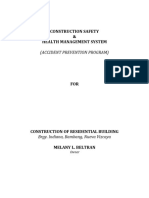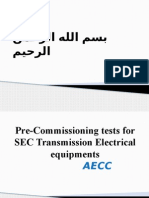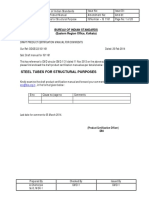Safety: Chapter - 1
Safety: Chapter - 1
Uploaded by
Bimbit PattanaikCopyright:
Available Formats
Safety: Chapter - 1
Safety: Chapter - 1
Uploaded by
Bimbit PattanaikOriginal Description:
Original Title
Copyright
Available Formats
Share this document
Did you find this document useful?
Is this content inappropriate?
Copyright:
Available Formats
Safety: Chapter - 1
Safety: Chapter - 1
Uploaded by
Bimbit PattanaikCopyright:
Available Formats
CHAPTER 1
SAFETY Plant start-up will commence after all plant operators and maintenance workers are well informed of the safety precautions necessary. Workers should be trained how to handle various situations which could arise, especially those involving dangerous chemicals or mechanical malfunction. They should know where the first aid, shower and eye wash stations, and fire extinguishers are. Care must be taken that the workers are informed of environmental practices as well. Only after they are aware of all safety procedures are they to be admitted to the plant. The minimum safety equipment that should be considered is; safety glasses, hard hats, safety shoes, and long-sleeved shirts & pants. All those who handle liquid chemicals would of course wear the recommended safety equipment designed for that purpose and have available a safety shower and eye wash. All maintenance personnel in the performance of their duties should be trained in the cautions regarding the liquids used in the plant. Suitable ventilation equipment such as fans should be used before working on enclosed spaces and opened pipes, or tanks. Lock-Out Tag-Out is the simplest form of electrical safety, yet the surest way to prevent accidents. Each employee that will be working on a machine personally will need a padlock in his possession for the purpose of locking the electrical box of the machine or machines that will be out of service. When the machine is taken out of service, the person responsible for locking the machine will place a padlock on the motor control box to prevent the machine from being turned on, except by him. The person who places the padlock on the control center then accepts the responsibility for all personnel who will be working on the equipment and will personally see that all is clear before removing the lock, allowing the equipment to be operated. No one other than the person, who placed the lock on the machinery, may remove the lock. All locks will be identified, so that other plant personnel may locate the person responsible for placing the lock on the machinery, in the event a lock has not been properly removed. Leader-Operator rules of safety apply to the reclaim procedures in addition to the normal equipment safety recommendations. Reclaim and shipping of bulk materials requires diligent observation of the storage and the accumulated material in the storage. When removing materials from the pile a vertical wall may never accumulate higher than the operators eyes. This prevents the operator from being covered by the material in the event that the wall collapses upon itself. The operator should never approach a wall that is higher than his eyes! The best way to prevent this situation from happening is to continually probe the upper pile section before removing the lower pile. Always scrape to the pile in order to maintain a clean floor that will remain a surface on which the optimum operational maneuvering can be accomplished. Never, load more into the loader bucket than the rated load for the machinery. Always wear your safety belt while operating the loader. Always set emergency brake before dismounting machinery.
Safety training should be designed based on local and national code required. Safety code in the United States is controlled by the Occupational Safety and Health Administration (OSHA). Refer to OSHA standards where local code is undefined. It is recommended that a Safety Booklet be printed and passed to the employees as a permanent referral tool when questions arise on the proper method for doing anything in the plant regarding plant safety. Regular safety meetings should be held to review problems or to entertain the employees concerns with the ongoing safety on the workplace. It is also advisable to award citations for outstanding examples of excellence, thereby encouraging others to follow suit. During the initial start-up period, equipment and raw materials must be inspected by members of Tekno-Kom Engineers prior to any mechanical or electrical operation to ensure proper installation.
You might also like
- 1 - FLM h130 - BasicDocument133 pages1 - FLM h130 - Basic韩超100% (2)
- Generic Heavy Equipment Operator SOPDocument3 pagesGeneric Heavy Equipment Operator SOPImran KhanNo ratings yet
- Trio 44x32 Twin FMW Operating ManualDocument33 pagesTrio 44x32 Twin FMW Operating ManualOrlando Melipillan100% (2)
- Method-Statement SignageDocument4 pagesMethod-Statement SignageGopan V Nair100% (2)
- Example JSA Job Safety AnalysisDocument13 pagesExample JSA Job Safety AnalysisPaulSwinbank100% (5)
- Demolition by HandDocument6 pagesDemolition by Handchassas100% (1)
- Kartika Mahatmya Damodar LilaDocument233 pagesKartika Mahatmya Damodar Lilacorons100% (3)
- ITP Fire FightingDocument2 pagesITP Fire FightingDiar Azzis S100% (1)
- 3 5Document2 pages3 5Ngọc PhụngNo ratings yet
- General Series Overhead Crane: User ManualDocument31 pagesGeneral Series Overhead Crane: User ManualjokoNo ratings yet
- Mechanical Trades SOPDocument5 pagesMechanical Trades SOPadventmanurungNo ratings yet
- Hazard Warning - 105 MPSDocument4 pagesHazard Warning - 105 MPSTuti SusilawatiNo ratings yet
- 10 Life Saving Rules ManualDocument32 pages10 Life Saving Rules ManualDamqn TodorovNo ratings yet
- Fire and First AidDocument14 pagesFire and First Aidhamojnr3No ratings yet
- Omegadyne Inc. Safety StatementDocument17 pagesOmegadyne Inc. Safety StatementStephanie BakerNo ratings yet
- Safety in Equipment OperationDocument13 pagesSafety in Equipment OperationAshok ShresthaNo ratings yet
- Hse in Drilling OperationsDocument13 pagesHse in Drilling OperationsSamad Ali Siddiqui100% (2)
- Why Machinery Safety ImportantDocument3 pagesWhy Machinery Safety ImportantmechjogeswardasNo ratings yet
- lockout-tag-outDocument6 pageslockout-tag-outdasmadhu1609No ratings yet
- Safety ProgramDocument26 pagesSafety ProgramDarine SfeirNo ratings yet
- Method Sattement For SEOT 27052022Document10 pagesMethod Sattement For SEOT 27052022Sujith KunjumonNo ratings yet
- 20.0 Machine GuardingDocument4 pages20.0 Machine GuardingRmz ExeNo ratings yet
- Truck Loading Machine Model TLM 1016 JDocument63 pagesTruck Loading Machine Model TLM 1016 Jzain140100% (1)
- Lifting Equipment at Work: A Brief GuideDocument36 pagesLifting Equipment at Work: A Brief GuideDrishti MehtaNo ratings yet
- Equipment Machinery Safety Checklist-Pdf-EnDocument2 pagesEquipment Machinery Safety Checklist-Pdf-EnOliver Reazon RueloNo ratings yet
- Health and Safety PolicyDocument1 pageHealth and Safety PolicyJeremiah NayosanNo ratings yet
- Chapter 6 - Housekeeping in PetrochemicalDocument25 pagesChapter 6 - Housekeeping in Petrochemicalchristina jeitolNo ratings yet
- Project Data1Document9 pagesProject Data1visputenilesh175No ratings yet
- d93310ab-e52b-4d08-98f2-b99852d21436Document168 pagesd93310ab-e52b-4d08-98f2-b99852d21436Zag LimNo ratings yet
- Orion Safety Manual Rev 2007Document186 pagesOrion Safety Manual Rev 2007jinyuan74No ratings yet
- Chapter 14 - Shop SafetyDocument11 pagesChapter 14 - Shop Safetymega87_2000No ratings yet
- Safety ProcedurePetropathDocument3 pagesSafety ProcedurePetropathrupa pamlNo ratings yet
- Workshop TechnologyDocument80 pagesWorkshop TechnologyGokul Prasad ChettiNo ratings yet
- Construction Safety & Health Management System: (Accident Prevention Program)Document8 pagesConstruction Safety & Health Management System: (Accident Prevention Program)carlito alvarezNo ratings yet
- Power and Hand ToolsDocument5 pagesPower and Hand Toolsammadbehram88No ratings yet
- Physical Hazards Machine ToolDocument3 pagesPhysical Hazards Machine ToolNamitaNo ratings yet
- UntitledDocument4 pagesUntitledMae DimarucutNo ratings yet
- Someks Manual GL1000 CompleteOperatorsManual enDocument135 pagesSomeks Manual GL1000 CompleteOperatorsManual endmitriy.astakhovNo ratings yet
- 13 SWPDocument11 pages13 SWPAshfaq AhmadNo ratings yet
- FMS Staion 8 Robotic ArmDocument20 pagesFMS Staion 8 Robotic ArmatihzNo ratings yet
- Health and Safety Policy - Part 4 Mechanical EquipmentDocument10 pagesHealth and Safety Policy - Part 4 Mechanical EquipmentMohsen SaidiNo ratings yet
- Emergency Responce Plan and Safety Plan Ram Chandra EnterpriseDocument4 pagesEmergency Responce Plan and Safety Plan Ram Chandra EnterpriseBilal QureshiNo ratings yet
- Maintenance Safety L3 Pre Ori 1.2Document14 pagesMaintenance Safety L3 Pre Ori 1.2PROMISE JULIUSNo ratings yet
- Safty ProgramDocument27 pagesSafty ProgramMohamed ReezaNo ratings yet
- Physhaz 0Document3 pagesPhyshaz 0Toka MohamedNo ratings yet
- Grader Operator SOPDocument2 pagesGrader Operator SOPdaniNo ratings yet
- Method Statement ExampleDocument4 pagesMethod Statement ExampleAya MagdyNo ratings yet
- Machine and Equipment Guarding: Group 5Document29 pagesMachine and Equipment Guarding: Group 5Ronald James DiazNo ratings yet
- EHS Requirements For Contracting WorksDocument5 pagesEHS Requirements For Contracting Workslaith.shaban.dermoshNo ratings yet
- Sop LotoDocument6 pagesSop Lotohse bsjNo ratings yet
- 0070 1654757177178Document85 pages0070 1654757177178Chuanwei WangNo ratings yet
- Peiner Motor Dual Scoop Grabs - MZG - S3 - NG30 - Part03 - ServiceDocument68 pagesPeiner Motor Dual Scoop Grabs - MZG - S3 - NG30 - Part03 - ServiceJan Ernst DepactoNo ratings yet
- Safe Work Method Statement WorksheetDocument7 pagesSafe Work Method Statement WorksheetianllagasNo ratings yet
- Lockout Tagout DLS Sample 2017Document12 pagesLockout Tagout DLS Sample 2017Archana SoorajNo ratings yet
- Safety in Engineering IndustryDocument8 pagesSafety in Engineering IndustryzombieNo ratings yet
- C&CStudyManual-03-31-21aDocument200 pagesC&CStudyManual-03-31-21alwittmer21No ratings yet
- Project:: SWP For Safe Use of MewpsDocument3 pagesProject:: SWP For Safe Use of MewpsVaradaraju Thirunavukkarasan100% (1)
- Heavy Equipment SOP FinalDocument9 pagesHeavy Equipment SOP FinalParmeshwor VetwalNo ratings yet
- Sample Method Statement PDFDocument10 pagesSample Method Statement PDFSujith KunjumonNo ratings yet
- Heavy Duty AssignmentDocument15 pagesHeavy Duty AssignmentSurafel MesfinNo ratings yet
- Ohs AuditDocument5 pagesOhs Auditmico fredNo ratings yet
- 008 A Nuñez Ma - ChristinaDocument5 pages008 A Nuñez Ma - Christinanunezmachristina.aitechNo ratings yet
- Centum VP System Overview HMIDocument46 pagesCentum VP System Overview HMIBimbit PattanaikNo ratings yet
- 5TV1874 20230223130307.039 XDocument1 page5TV1874 20230223130307.039 XBimbit PattanaikNo ratings yet
- Atrological InterpretationDocument72 pagesAtrological InterpretationBimbit PattanaikNo ratings yet
- Bhagabata Odiya 1Document58 pagesBhagabata Odiya 1Bimbit PattanaikNo ratings yet
- 5LV1812 20230223130402.493 XDocument1 page5LV1812 20230223130402.493 XBimbit PattanaikNo ratings yet
- Bagging Plant Presentation - PpsDocument5 pagesBagging Plant Presentation - PpsBimbit Pattanaik100% (1)
- Effective Team BuildingDocument44 pagesEffective Team BuildingBimbit PattanaikNo ratings yet
- Bagging Plant Zypmite Plant Mop Bagging Rilway In-Motion: Bimbit Kumar PattanaikDocument9 pagesBagging Plant Zypmite Plant Mop Bagging Rilway In-Motion: Bimbit Kumar PattanaikBimbit PattanaikNo ratings yet
- Giving Thanks: "Chance Favors The Prepared Mind."Document1 pageGiving Thanks: "Chance Favors The Prepared Mind."Bimbit PattanaikNo ratings yet
- Houses From Arudha LagnaDocument10 pagesHouses From Arudha LagnaBimbit Pattanaik100% (1)
- Fakir Mohan Senapati Odiya ShortStories PDFDocument172 pagesFakir Mohan Senapati Odiya ShortStories PDFBimbit Pattanaik73% (33)
- Technokom Contents PDFDocument1 pageTechnokom Contents PDFBimbit PattanaikNo ratings yet
- Simon India Limited,: Dupont Sustainable SolutionsDocument1 pageSimon India Limited,: Dupont Sustainable SolutionsBimbit PattanaikNo ratings yet
- Pid 321 121 1C - R3 PDFDocument1 pagePid 321 121 1C - R3 PDFBimbit PattanaikNo ratings yet
- Mantrapuspam OdiDocument3 pagesMantrapuspam OdiBimbit PattanaikNo ratings yet
- IP Release Notes Guide: Intellectual Property Xilinx Download CenterDocument47 pagesIP Release Notes Guide: Intellectual Property Xilinx Download Centersappal73asNo ratings yet
- m2m Ethernet En-GbDocument30 pagesm2m Ethernet En-GbAnthony Flores ValeraNo ratings yet
- Beginners Python Cheat Sheet PCC AllDocument14 pagesBeginners Python Cheat Sheet PCC AllTelmo Joao Magalhaes OliveiraNo ratings yet
- Proposed Design For Harvey's GardenDocument6 pagesProposed Design For Harvey's GardenNewsChannel 9No ratings yet
- Catalogue Rotary Cam SwitchesDocument92 pagesCatalogue Rotary Cam Switchesrajpre1213No ratings yet
- API 16B Julio - Final InglesDocument138 pagesAPI 16B Julio - Final Inglescrr97hotmailesNo ratings yet
- BS 7965-2013.part1Document12 pagesBS 7965-2013.part1penjualgasNo ratings yet
- KPS - Industrial Enclosures Broch 20091208Document2 pagesKPS - Industrial Enclosures Broch 20091208MatthewHarveyNo ratings yet
- 01-Pre-Commissioning Tests For SEC Transmission Electrical EquipmentsDocument38 pages01-Pre-Commissioning Tests For SEC Transmission Electrical EquipmentsThameemul BuhariNo ratings yet
- Toyota Global Strategy and Specific Strategy in ChinaDocument7 pagesToyota Global Strategy and Specific Strategy in ChinaYK ZhouNo ratings yet
- Kapsch KTC Ds Avc en 03Document2 pagesKapsch KTC Ds Avc en 03AmitChakrabortyNo ratings yet
- Solenoid Valve SCE272ADocument2 pagesSolenoid Valve SCE272AVictor Ruiz FuentesNo ratings yet
- Steel Tubes For Structural Purposes: Bureau of Indian StandardsDocument22 pagesSteel Tubes For Structural Purposes: Bureau of Indian StandardsAmit GauravNo ratings yet
- CG1 02Document2 pagesCG1 02vomoriNo ratings yet
- Vacancy-EASA TRN 2018 001Document8 pagesVacancy-EASA TRN 2018 001dadaenmjeNo ratings yet
- SC3 Om en 05Document52 pagesSC3 Om en 05jads30117975% (4)
- SM-A307F Manual de Servicio Anibal Garcia IrepairDocument109 pagesSM-A307F Manual de Servicio Anibal Garcia Irepairega30No ratings yet
- 2D Barcode Scanner User Manual.Document10 pages2D Barcode Scanner User Manual.N MNo ratings yet
- Fans & Blowers - Fabie, Montalban, Pardo, RomeroDocument29 pagesFans & Blowers - Fabie, Montalban, Pardo, Romeronagmajerald17No ratings yet
- Türk Telekom SunumuDocument16 pagesTürk Telekom SunumuudikiciNo ratings yet
- Amsoil Ea Oil Filters (Eao - Ea15k)Document2 pagesAmsoil Ea Oil Filters (Eao - Ea15k)amsoildealerNo ratings yet
- IE10 Series Sarix Integrated Rugged Fixed Dome: Product SpecificationDocument4 pagesIE10 Series Sarix Integrated Rugged Fixed Dome: Product SpecificationFernando Del CampoNo ratings yet
- Spec Piping Material PDFDocument18 pagesSpec Piping Material PDFMuchamad FaizNo ratings yet
- 1 3GPPDocument24 pages1 3GPPMahamoud HamoudNo ratings yet
- Iso 8362 2 2015Document9 pagesIso 8362 2 2015Diego CorreiaNo ratings yet
- Emerson EC20 Series PLC - ENGDocument3 pagesEmerson EC20 Series PLC - ENGsachin wadnereNo ratings yet
- ABB I-Bus Eib / KNX Switch Actuator, X-Fold, 16 A, MDRC SA/S x.16.1, 2CDG 110 0xx R0011Document4 pagesABB I-Bus Eib / KNX Switch Actuator, X-Fold, 16 A, MDRC SA/S x.16.1, 2CDG 110 0xx R0011pkmhussainNo ratings yet









































































































